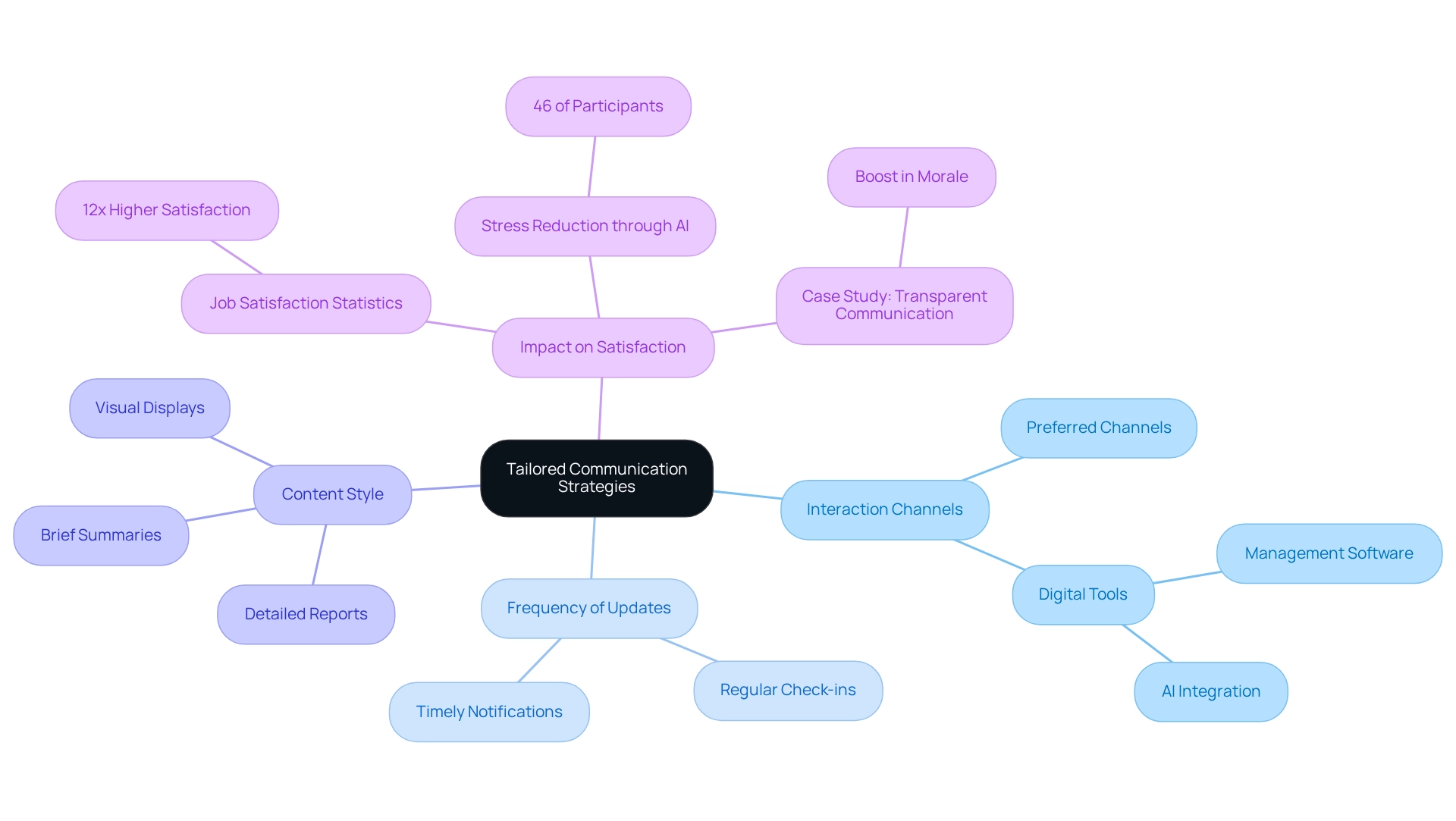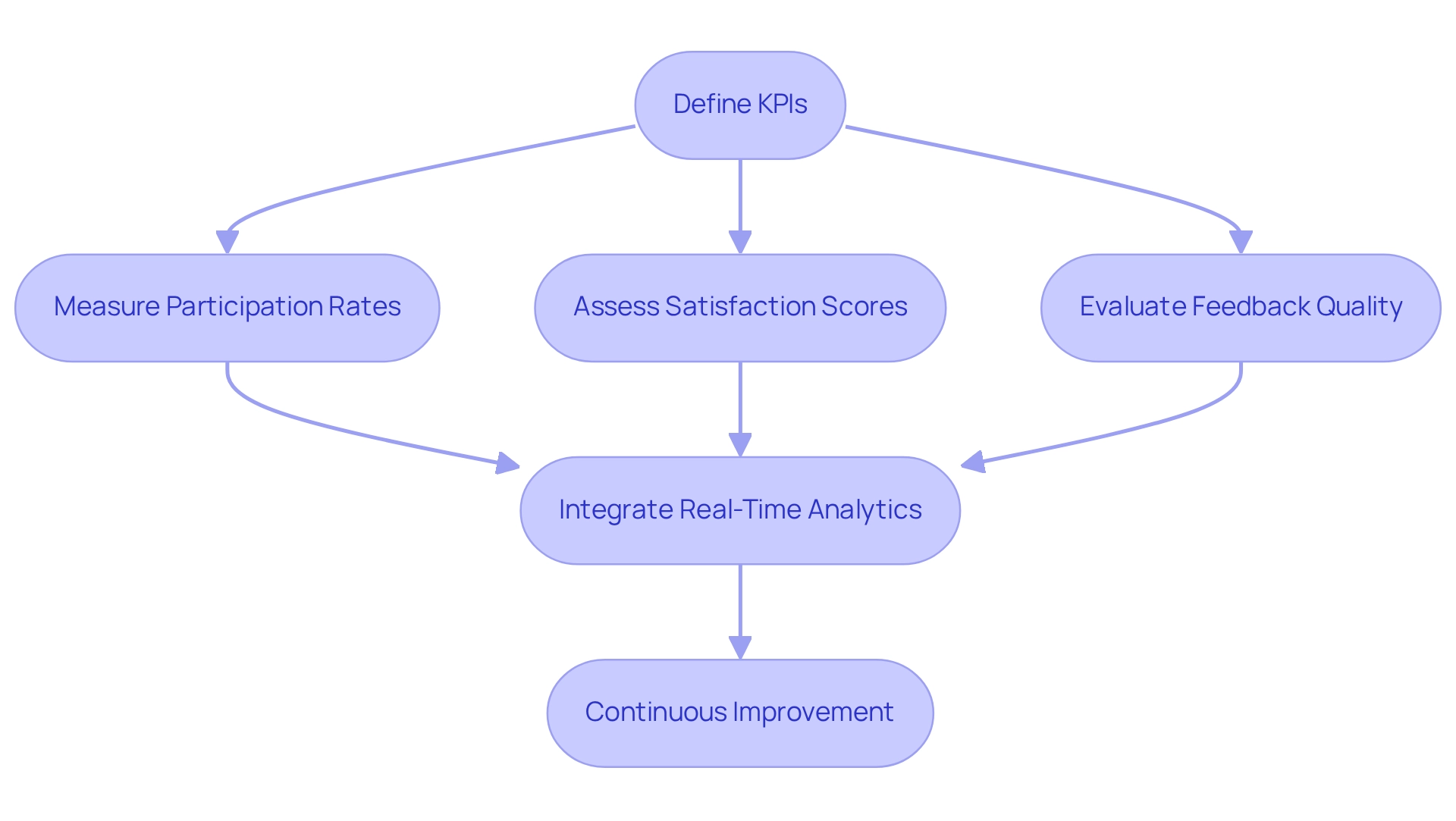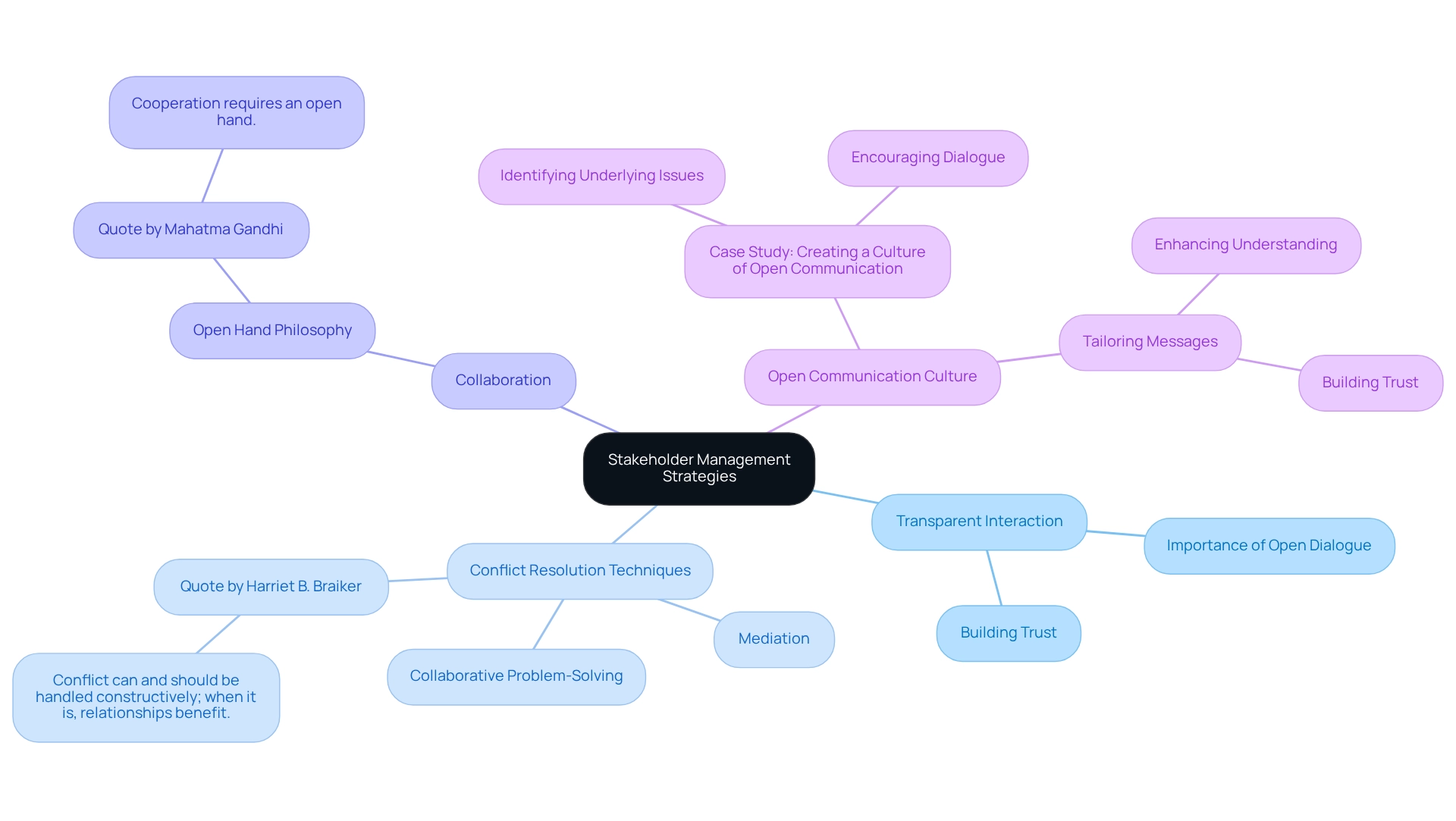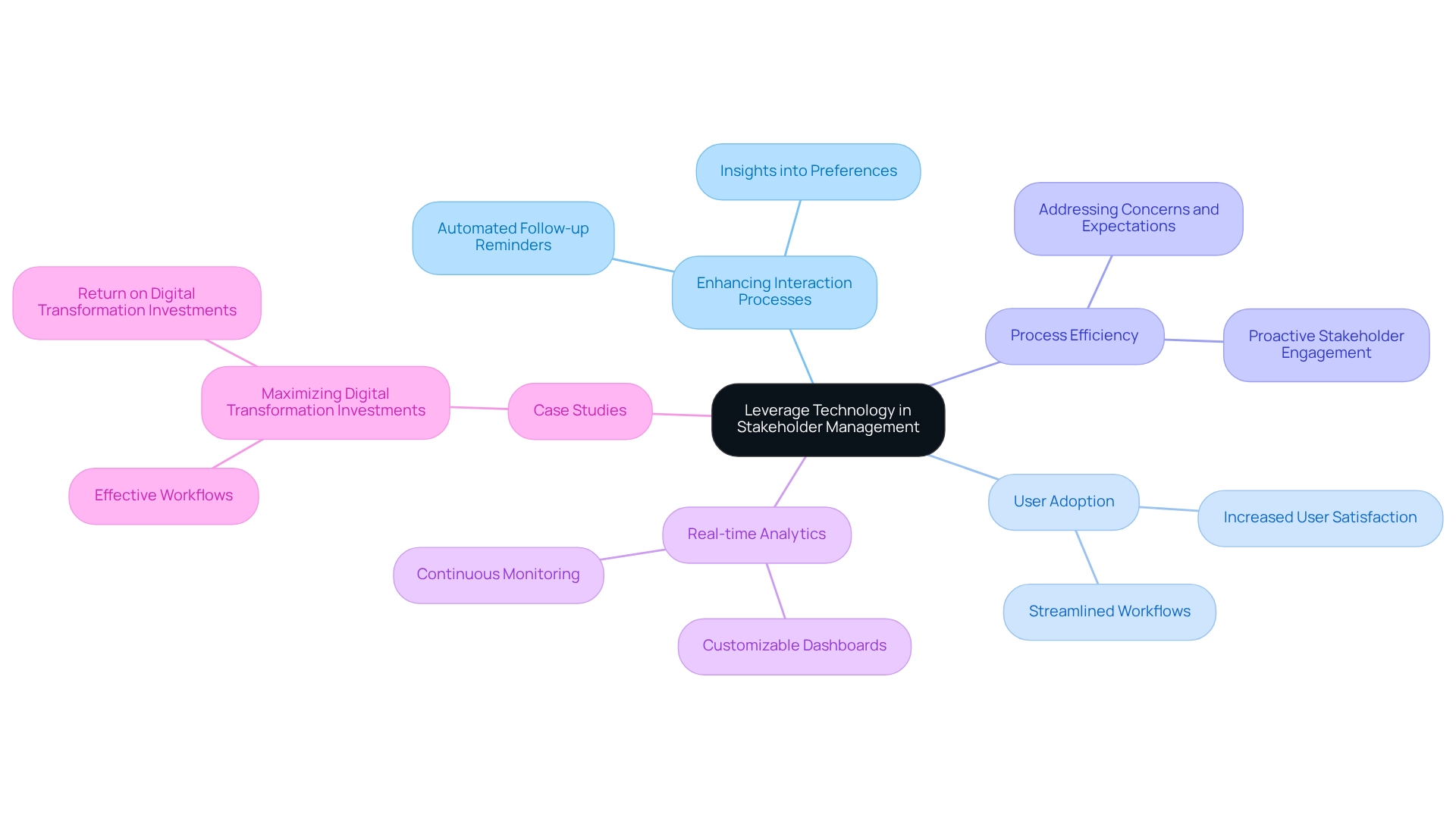Overview
This article delves into the critical considerations for tailoring processes in project stakeholder management. It underscores the necessity of comprehending stakeholder needs, fostering effective communication, and maintaining ongoing engagement. By implementing strategies such as stakeholder classification, feedback mechanisms, and technology integration, organizations can significantly enhance relationships. This not only ensures mutual benefits but also leads to improved project outcomes and sustained success. The importance of these elements cannot be overstated, as they are foundational to achieving project excellence.
Introduction
In today's dynamic business landscape, effective stakeholder management has emerged as a cornerstone of organizational success. Understanding stakeholder needs is not merely a checkbox on a to-do list; it is a fundamental aspect that can propel a project from mere concept to successful execution.
By employing comprehensive research methods and leveraging digital tools, organizations can craft personalized communication strategies that resonate with diverse stakeholder interests. As businesses navigate complexities and strive for sustainable growth, the ability to align stakeholder expectations with project goals becomes increasingly vital.
This article delves into essential strategies for enhancing stakeholder engagement, exploring the importance of:
- Continuous feedback mechanisms
- Conflict resolution
- The integration of technology to foster long-term relationships that ensure mutual benefit and project success.
Understand Stakeholder Needs: The Foundation of Effective Management
Effective management of interested parties begins with comprehensive research to uncover their needs, preferences, and concerns. At Transform Your Small/Medium Business, we initiate each client collaboration with a thorough business assessment, aligning key participants to gain deeper insights into the business context beyond mere figures. Utilizing tools such as surveys, interviews, and focus groups can yield valuable insights that inform your engagement strategies. This foundational understanding is crucial for customizing communication to align with the interests of involved parties.
For instance, if these individuals express a desire for transparency, implementing regular updates and facilitating open forums for discussion can be beneficial. Such proactive measures not only cultivate trust but also significantly enhance satisfaction among involved parties and ensure project alignment. Notably, businesses that actively engage with their constituents tend to perform 15% better in achieving their strategic goals, underscoring the importance of effective interaction with those involved. Additionally, with 39% of social media users seeking prompt replies, timely communication is essential for preserving strong relationships with involved parties.
By emphasizing participant research and involvement, organizations can tackle challenges more efficiently and achieve favorable results. As Cornelius Fichtner states, 'Comprehending the requirements of involved parties is vital for project success,' highlighting the significance of this essential task. Furthermore, considering that 50% of a company's value often arises from just 15-20 critical roles, acknowledging and catering to their needs can greatly influence overall business performance. By incorporating a personal element into interactions with interested parties, organizations can further enhance their involvement initiatives.
Identify and Classify Stakeholders: Prioritizing Engagement Efforts
When tailoring processes for project stakeholder management, you should consider all of these except:
- Identifying all potential stakeholders and categorizing them based on their influence and interest in the initiative.
- Employing tools such as the Power/Interest Grid, which facilitates a clear visualization of this classification.
- Prioritizing stakeholders identified as high-power and high-interest, as their influence can significantly affect outcomes.
- Those classified as low-power and low-interest, which necessitate minimal communication efforts, thereby ensuring resources are allocated efficiently; for instance, a project manager may prioritize engagement with senior executives who possess the authority to impact project funding decisions.
- Regular updates can be provided to less influential parties, avoiding inundating them with excessive information.
This strategic approach not only strengthens relationships with involved parties but also aligns with findings indicating that 50% of a company’s value often derives from just 15-20 key roles within those parties. When tailoring processes for project stakeholder management, you should consider all of these except:
- The understanding of Engagement ROI, which is essential. This framework assesses the costs and benefits of participant involvement.
- Leading to improved planning and decision-making.
- The insights gained from analyzing Engagement ROI, which can help organizations understand the value of participant collaboration and guide their investment strategies and risk management efforts.
Recent research has underscored the significance of the Power/Interest Grid in participant analysis, particularly when tailoring processes for project stakeholder management. You should consider all of these except:
- Its role in fostering efficient interaction strategies.
- Implementing a 'Test & Measure' approach by examining data from participant interactions to evaluate the effectiveness of their engagement strategies, ensuring that efforts align with strategic business enhancement initiatives.
Develop Tailored Communication Strategies: Engage Effectively with Stakeholders
To successfully engage interested parties, it is essential to develop messaging strategies that align with their preferences and expectations. This involves evaluating various elements such as:
- Preferred interaction channels
- Frequency of updates
- Content style
For instance, while some parties may value detailed reports, others might prefer brief summaries or visual displays that convey information swiftly.
In 2025, effective strategies for sharing information are more crucial than ever, as they significantly influence party satisfaction. Studies indicate that workers who engage in open dialogue report 12 times greater job satisfaction compared to those in environments with insufficient interaction. This underscores the necessity of aligning interactions with the preferences of interested parties to foster a positive relationship.
Employing digital tools, such as management software tailored for interested parties, can streamline the creation of personalized interaction plans customized to individual needs. These tools not only enhance the effectiveness of interactions but also ensure that messages resonate with each interest group, ultimately leading to improved project outcomes and participant satisfaction. Furthermore, effective interaction tools can bridge the gap between remote and on-site workers, ensuring that all stakeholders remain informed and engaged, regardless of their location.
As Marija Kojic noted, 46% of participants believe that the use of AI has reduced their stress levels, highlighting the potential benefits of integrating advanced technologies into interaction strategies. Additionally, the case study titled 'Transparent Internal Communication: A 12x Satisfaction Boost' illustrates how enhancing transparency in communication can significantly elevate employee morale and satisfaction.

Align Stakeholder Interests with Project Goals: Ensuring Mutual Benefit
When tailoring processes for project stakeholder management you should consider all of these except involving interested parties in significant conversations to reveal their priorities and worries, which is crucial for aligning these with objectives. This cooperative method promotes confidence and motivates participants to actively invest in the initiative's success. For instance, if an interested party expresses concern about environmental impact, incorporating sustainable practices into the initiative not only addresses their worries but also enhances the overall reputation of the endeavor.
Statistics reveal that companies prioritizing interest group management experience a 40% reduction in delays, underscoring the significance of this alignment in achieving sustainable growth. A case study titled 'Sustaining Stakeholder Support Throughout the Project Lifecycle' highlights the necessity of ongoing engagement beyond initial support.
When tailoring processes for project stakeholder management you should consider all of these except essential strategies like openness, consistent updates, and creating feedback loops, which are vital for preserving participant engagement during the initiative. The results suggest that initiatives involving participant input and sustaining transparent communication are more prone to thrive; contributors feel appreciated and involved, which is essential for addressing obstacles and attaining lasting development.
Furthermore, expert insights highlight that efficient collaboration with participants is crucial for initiative success. As pointed out by Emmanuel Acquah, a respected expert in involving participants, 'Engaging employees effectively cultivates motivation, ownership, and teamwork, ensuring that objectives are achieved efficiently.' By prioritizing collaboration with interested parties, organizations can not only achieve project objectives but also cultivate long-term relationships that contribute to sustainable growth.

Transform Your Small/ Medium Business: Enhancing Stakeholder Engagement Processes
Small and medium enterprises must adopt adaptable interaction methods that can swiftly adjust to the evolving requirements of involved parties. Establishing regular feedback loops and participant forums is crucial for promoting transparent dialogue, enabling immediate modifications to engagement strategies.
For instance, a restaurant could implement quarterly meetings with local community members to solicit feedback on menu changes, ensuring their offerings resonate with customer preferences. This approach not only enhances participant satisfaction but also strengthens community ties, ultimately driving business success.
Moreover, statistics reveal that 39% of social media users anticipate prompt replies, underscoring the necessity for flexible interaction strategies among all stakeholder groups. To support these adaptable interaction processes, businesses should consider structured communication strategies, such as:
- Monthly board meetings for executive-level updates
- Weekly team meetings for operational progress
By prioritizing these flexible engagement processes, businesses can cultivate trust and commitment—essential elements for navigating challenges and achieving sustainable growth.
Furthermore, utilizing real-time business analytics via a client dashboard can significantly improve decision-making processes, ensuring organizations remain responsive to the needs of their partners and market dynamics. Insights from case studies emphasize the importance of transparency in preserving trust among interested parties throughout the lifecycle, particularly in relation to the current Economic Recovery Plan.
Implement Continuous Feedback Mechanisms: Adapt Strategies for Success
Creating ongoing feedback systems is essential for collecting insights from participants throughout the lifecycle. By utilizing surveys, interviews, and digital platforms, managers can collect feedback regularly, fostering an iterative approach that allows for timely adjustments to involvement strategies. This guarantees that the strategies remain pertinent and efficient.
For instance, conducting monthly surveys assists in measuring participant satisfaction and identifying areas for enhancement. Research indicates that organizations prioritizing performance management are increasingly adopting such practices; 58% of HR professionals expect more frequent feedback in the coming years. This change highlights the significance of ongoing feedback systems in improving participant involvement and initiative success. Moreover, routine participant surveys can greatly influence initiative results.
When tailoring processes for project stakeholder management, you should consider all of these except the need for managers to actively pursue feedback, which helps identify potential issues early and enables proactive solutions that align with the expectations of interested parties. This iterative interaction not only strengthens relationships but also drives collaboration, ultimately leading to more successful project completions.

Measure Stakeholder Engagement Effectiveness: Refine Approaches for Better Outcomes
To effectively measure involvement from interested parties, it is essential to develop key performance indicators (KPIs) that assess not only participation rates, satisfaction scores, and feedback quality but also integrate real-time analytics through our client dashboard for continuous improvement. Metrics such as attendance at participant meetings, combined with insights from the dashboard, provide valuable data on engagement strategies.
By examining this feedback in real-time, you can determine which methods are most effective and identify necessary modifications. This ensures a more adaptive approach to managing interested parties that aligns with the turnaround process.

Address Conflicts and Challenges: Navigating Stakeholder Management Issues
Proactively tackle disputes and obstacles by promoting transparent interaction and encouraging conversation among involved parties. Utilize conflict resolution techniques such as mediation and collaborative problem-solving to navigate disputes effectively. As psychologist and author Harriet B. Braiker states, "Conflict can and should be handled constructively; when it is, relationships benefit." For instance, when two parties have conflicting interests, fostering a conversation to find common ground can yield mutually advantageous outcomes.
Mahatma Gandhi emphasized that collaboration requires an open hand, underscoring the importance of transparent dialogue in managing involved parties. Moreover, statistics indicate that when tailoring processes for project stakeholder management you should consider all of these except that messages should meet the specific interests of the parties involved to enhance comprehension and foster trust, which is vital for long-term success.
A case study on cultivating a culture of open communication illustrates that encouraging dialogue enables organizations to identify and address underlying issues effectively, leading to improved conflict management outcomes. By prioritizing these strategies, organizations can adeptly navigate challenges posed by interested parties and foster a collaborative project environment.

Leverage Technology and Tools: Streamline Stakeholder Management Processes
Utilizing management software and digital tools is crucial for enhancing interaction processes. These technologies empower organizations to effectively monitor interactions with interested parties, manage correspondence, and assess participation data. For instance, a robust management platform can automate follow-up reminders and provide insights into preferences, significantly improving interaction efficiency.
In 2025, the incorporation of technology in management is more essential than ever. Companies that prioritize user adoption and process efficiency are better positioned to maximize the benefits of their digital transformation efforts. Statistics reveal that 39% of social media users expect prompt replies, underscoring the necessity of swift and efficient strategies among all involved groups when tailoring processes for project stakeholder management you should consider all of these except.
Additionally, digital tools not only enhance communication but also facilitate improved documentation and prioritization of concerns from involved groups, which is vital for success in stakeholder capitalism. Effective digital tools include platforms that offer real-time analytics and customizable dashboards, which are important when tailoring processes for project stakeholder management you should consider all of these except enabling organizations to adapt their interaction strategies to meet specific participant needs while continuously monitoring business health.
Case studies illustrate the impact of these technologies; for example, firms that have implemented streamlined workflows in their participant management processes report increased levels of user adoption and satisfaction. Expert insights indicate that investing in the appropriate software can lead to substantial improvements in participant interaction efficiency, ultimately resulting in enhanced project outcomes.

Foster Long-Term Relationships: Ensure Sustained Success in Stakeholder Management
Investing in long-term connections with interested parties is essential for ongoing success. Regular communication, including updates and feedback solicitation, fosters trust and engagement. Recognizing participant contributions not only enhances morale but also promotes active involvement in decision-making processes.
For instance, organizing yearly appreciation events for partners can greatly strengthen these connections, demonstrating a dedication to collaboration and shared success. Such initiatives not only boost participant loyalty but also aid in creating a more unified environment, ultimately resulting in reduced conflict resolution expenses through proactive problem-solving.
When tailoring processes for project stakeholder management, you should consider all of these except:
- How to effectively communicate strategies to meet the needs of various stakeholder groups, ensuring that all parties remain informed and engaged, which paves the way for successful project outcomes.
Conclusion
Understanding and actively managing stakeholder relationships is paramount for achieving organizational success in today’s fast-paced business environment. This article has highlighted several key strategies that can enhance stakeholder engagement, emphasizing the importance of continuous feedback mechanisms, conflict resolution, and the integration of technology in fostering long-term relationships.
By prioritizing stakeholder needs through comprehensive research, organizations can tailor their communication strategies to resonate with diverse interests, ultimately driving project success. Mapping and classifying stakeholders ensures that engagement efforts are focused and efficient. Moreover, developing customized communication plans aligns with stakeholder preferences, enhancing satisfaction and collaboration.
Furthermore, implementing continuous feedback systems allows organizations to adapt strategies in real-time, ensuring that stakeholder expectations are consistently met. Addressing conflicts through open communication fosters a cooperative environment. In addition, leveraging technology streamlines engagement processes, making interactions more effective and efficient.
Ultimately, fostering long-term relationships with stakeholders not only solidifies trust but also contributes to sustainable growth and project success. As organizations navigate the complexities of stakeholder management, embracing these strategies will be crucial in building resilient partnerships that thrive in an ever-evolving business landscape.
Frequently Asked Questions
How can businesses effectively manage interested parties?
Effective management begins with comprehensive research to uncover the needs, preferences, and concerns of interested parties. This includes conducting thorough business assessments and utilizing tools such as surveys, interviews, and focus groups to gather valuable insights.
Why is understanding stakeholder needs important?
Understanding stakeholder needs is crucial for project success as it allows businesses to customize communication and engagement strategies, thereby cultivating trust and enhancing satisfaction among involved parties.
What are some examples of proactive measures to engage stakeholders?
Proactive measures include implementing regular updates and facilitating open forums for discussion, especially if stakeholders express a desire for transparency.
What impact does stakeholder engagement have on business performance?
Businesses that actively engage with their constituents tend to perform 15% better in achieving their strategic goals, highlighting the importance of effective interaction.
How important is timely communication with stakeholders?
Timely communication is essential for preserving strong relationships, as 39% of social media users expect prompt replies.
What tools can help in stakeholder management?
Tools like the Power/Interest Grid can help categorize stakeholders based on their influence and interest, allowing for efficient allocation of communication efforts.
How should stakeholders be prioritized in management strategies?
Stakeholders identified as high-power and high-interest should be prioritized, while those classified as low-power and low-interest may require minimal communication to allocate resources efficiently.
What role does Engagement ROI play in stakeholder management?
Engagement ROI helps assess the costs and benefits of participant involvement, leading to improved planning and decision-making.
What factors should be considered when developing messaging strategies for stakeholders?
Key factors include preferred interaction channels, frequency of updates, and content style to ensure messaging aligns with stakeholder preferences.
How can digital tools enhance stakeholder interaction?
Digital tools can streamline the creation of personalized interaction plans, ensuring messages resonate with each interest group and improving overall project outcomes and satisfaction.
What is the significance of transparency in communication?
Enhancing transparency in communication can significantly elevate employee morale and satisfaction, as demonstrated by case studies showing a boost in satisfaction levels.




